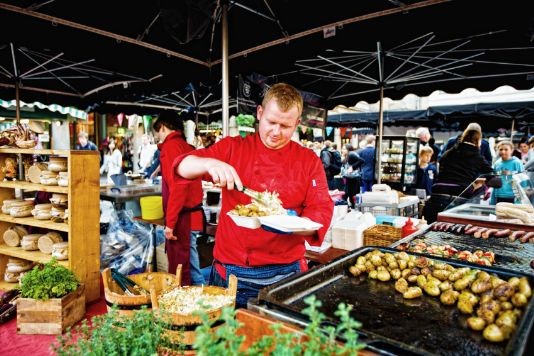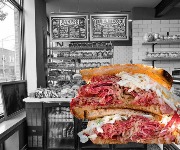Does Britain have a street food culture?

`Britain's best burgers' may now be sold in a van rather than a restaurant, but have we truly embraced the street food culture?
Forget snooty restaurants perched atop Michelin-garlanded pedestals. Some of the most flavoursome food in the world is sold from stalls, vans, trailers and carts – in public spaces like pavements, markets, fairs, festivals, beaches and parks. It’s cooked quickly and served with minimum fuss, without silly garnishes or pretentious wines to match.
But when the British Street Food Awards officially launched last year (after a search for street food heroes during 2009), I did wonder what British street food really was. Roast chestnuts selling on Oxford Street? Mr Whippy ice cream vans and dodgy hot dog carts? Yet 18 months later, we have a rapidly flourishing street food scene that appears to have come out of nowhere.
British street food
Street food in Britain is not new, however. The first published evidence dates back to the 11th century, when fast-food ‘cookshops’ did brisk business in London and other cities like Norwich, Leicester and York. They sold pies, flans, tarts and pasties, filled with meats like veal, goose and goat.
In the Victorian times, popular street foods included pickled whelks, sheep’s trotters, hot pea soup and gooseberry pie. Then “something… happened along the way, and we became prudish”, explains food journalist Richard Johnson, author of ‘Street Food Revolution’. “By the end of the Victorian era, eating in public was something suitable only for the working classes.”
Johnson adds: “It took the burgeoning farmers’ market movement to make street food popular again. Thanks to the markets, it became acceptable (and acceptably middle class) to eat a sausage in a bun – if the sausage was rare breed, and the bun was a hand-drawn sourdough. Then the music festivals got with it, and a whole new generation considered street food.”
Johnson founded the British Street Food Awards to recognise outstanding talent, and to ultimately change the way we eat.
Increasing variety
In Britain, I think the street food buzz started in Asian restaurants like Imli a few years ago. Now we have around 10,000 individual vendors, dishing out everything from home-made Gujarati snacks and Goan seafood, to ‘Britain’s best burgers’, gourmet chocolate and ice creams in imaginative flavours.
They typically specialise in one type of dish, which they focus on doing very well. The current trends are Vietnamese banh mi sandwiches, Mexican burritos, upmarket hotdogs and gourmet ice creams. Classic burgers, of course, never go out of fashion. The Eat Street website is an excellent source of news and information about new vendors.
So do we now have a street food culture?
Early days
In Asia, Mexico and many other parts of the world, the vibrant, colourful street food is such a crucial component of the national psyche that life – or at least eating out – is unthinkable without it.
Malaysians grab lip-smackingly spicy nasi lemak on their way to work, Israelis queue up for feather-light falafels; and in India, a memsahib in a sparkling saree will arrive at a revered vendor in a chauffeur-driven car to indulge her love of hot and tangy chaat.
In the USA, where you’ll find everything from lobster rolls in Maine, to Korean bulgogi in New York, street food awards and festivals have been established for years.
In Britain, it’s still early days. Street food isn’t available on every street corner like in some countries – we have to seek it out. Its current appeal is confined to foodies in the know. We haven’t yet developed a street food lifestyle or mindset.
However, things are changing rapidly, and I believe we’re on the cusp of establishing our own street food identity – not least because the way we eat and communicate about food has been changing dramatically. The advent of supper clubs and pop-up restaurants means that eating out is not only about conventional bricks and mortar restaurants. Thanks to food blogs and Twitter, word about exciting new discoveries gets around quickly.
The biggest appeal of such democratic fare is that it’s down-to-earth and un-snobby. Dishes are usually freshly made to order and have a sense of immediacy and spontaneity. There are few barriers between vendors – often colourful, passionate characters – and customers, who can give on-the-spot feedback.
In making good food accessible to all, the current wave of street food vendors are finally making us a nation of true food lovers, as opposed to restaurant snobs.
Your thoughts
So what’s your opinion on street food in Britain? Is it now acceptable to eat in public spaces with sauce dribbling down our chins, or are we Brits too proper? What would you like British street food to be?
This year’s British Street Food Awards will be announced at the Harvest at Jimmy’s festival, 9 – 12 September. You can vote for the ‘Best Looking Mobiler’ via its Facebook page.
Also worth your attention:
Most Recent
Comments
Be the first to comment
Do you want to comment on this article? You need to be signed in for this feature








